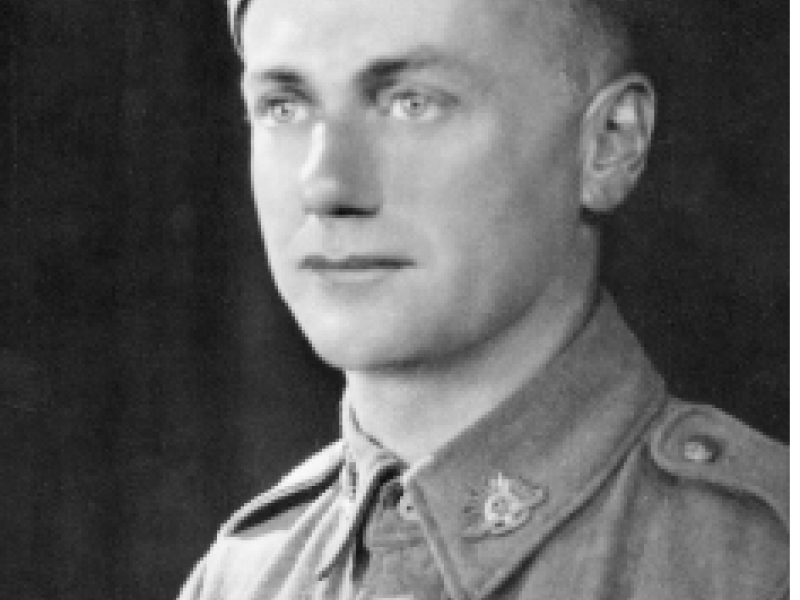Nicholas Gordon McIllree
Nicholas was born on the 25th of October 1900 at Corryong, Victoria. He was the second of four children of Robert and Laura Lindsay (née Milligan) McIllree. Nicholas’ mother, Laura, passed away in 1934 at Manly near Sydney.
Australian Electoral Rolls provide a picture of Nicholas’ whereabouts. In 1930 he lived at 480 Parkinson Street in Albury. By 1937 he had moved to Dubbo in central NSW and was living at the Macquarie View Hotel. In both cases his occupation was listed as a bank clerk for the Commercial Banking Company of Sydney
Nicholas initially enlisted in the Australian Militia Forces on the 16th of September 1938, being allocated the Army Number 434450 and joining C Company of the 20/54th Battalion in Dubbo, NSW.
On the 17th of November 1939, he transferred to the 2nd AIF in Sydney, NSW. He was allocated the Army Number NX8786 and placed on the roll of the 2/4th Battalion. On that day he marched into the 2nd AIF’s first purpose-built training camp of infantry at Ingleburn, NSW. The initial conditions at the camp were sparse. Buildings had not been completed and as troops moved in carpenters were still working on the floors of huts.
After initial training, on the 10th of January 1940, the 2/4th Battalion entrained and travelled to Sydney where they embarked on HMT Strathnaver. The convoy sailed through Sydney Heads at 1330 hours and joined New Zealand ships about 50 kilometres out. This made a convoy of ten ships escorted by three cruisers (including HMAS Canberra and HMAS Australia) and the battleship HMS Ramillies. As the convoy passed Wilson’s Promentory they were joined by the Empress of Japan loaded with troops from Victoria. Throughout the journey the troops continued to undergo training, including physical, tactical lectures and weapons drill.
During the journey, escort ships changed and some went off on other duties. By the time the convoy had reached the southern entrance to the Suez Canal there were only four troopships (Orion, Orcades, Empress of Japan and Strathnaver) and one escort, HMAS Hobart. As the troopships entered the canal, Hobart bade them farewell. On the 13th of February the troops disembarked at El Kantara, Egypt, (now called El Qantara) arriving at camp at Gaza early the next day.
The battalion moved to Kilo 89 Camp at Gaza Ridge in Palestine to continue training in desert warfare techniques. Nicholas’ service records are difficult to interpret after embarkation. It appears that between February of August of 1940 he attended a number of different courses and, for a period of six weeks, was transferred to “Y” Regiment RAA (Royal Australian Artillery), a light anti-aircraft unit of the 2/1st Field Regiment used to provide air defence around Haifa, Palestine. By mid-August he was back with the battalion, still at Kilo 89.
In early January 1941, the 2/4th Battalion played a small role in the capture of the Italian Garrison town of Bardia. It was more active during the battle of Tobruk (21st and 22nd of January), and fought particularly hard to secure Wadi Derna (26th to 30th of January). It was the first Australian unit to enter the town of Benghazi on the 6th of February, and garrisoned the town until the 22nd of February.
In early April of 1941 the battalion, along with the rest of the 6th Division, deployed to Greece to provide support for the anticipated German invasion, after Italian forces had suffered tremendous casualties. It fought a fierce battle at Vevi on April the 11th and 12th and then withdrew through a series of rearguard positions to the sea. They evacuated to Crete and joined the force defending the Heralion airfield. When German paratroopers landed on the 20th of May they were rapidly overcome. After heavy fighting, the 2/4th made their way to the south coast of Crete so that they could be evacuated by the Royal Navy.
Nine days later the battalion had been taken off the Cretan beaches and were scattered throughout a number of RN ships. As the convoy tried to make their way back to Alexandria, it went through nearly nine hours of consistent attacks by Stuka divebombers. Many of the ships were hit and casualties were heavy. Nicholas’ records indicate that he had been wounded, whether during the retreat or whilst on the ships, is unknown. Unfortunately on the 30th of May, Nicholas died, the cause being noted as “pulmonary percussion - gas poisoning”. This was most likely a case of gas gangrene which occurs when bacteria comes into contact with a wound.
Upon arriving back at Alexandria, Nicholas’ body was buried in the Alexandria (Chatby) Military and War Cemetery, situated on the eastern side of the city of Alexandria, Egypt.
Nicholas is remembered on the Australian War Memorial Roll of Honour, the Albury Grammar School Honour Roll, the Commercial Banking Company of Sydney WW2 Honour Roll and the Corryong War Memorial. For his service, he was awarded the 1939-1945 Star, the Africa Star, the Defence Medal, the War Medal 1939-1945 and the Australian Service Medal 1939-1945.

 Stephen Learmonth
Stephen Learmonth